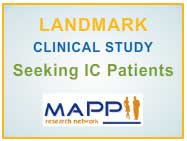Discuss this article on the forums
One could argue that Day Three was the most important of the meeting. After all what people with ME/CFS vitally need are treatment and research centers doing rigorous work on the disorder and only the feds will provide that kind of money. In fact the federal government did fund 3 research centers for a time but those are long gone…
After Dr. Klimas’s, Dr. Lights, Dr. Glasers and Dr. Lerners testimony it was clear there was enough expertise already sitting in that room to lead several research and treatment centers. Dr. Klimas, in fact, did lead a federally funded research center for a few years; one can only guess at what SHE would have accomplished over the past 10 years if she had a well funded center to support her. Her report suggesting that immune system problems (pathogens, fatigue and pain) could trigger the sympathetic nervous system arousal (inability to relax, pain, circulation problems, low blood volume?) is almost painfully exciting given the federal governments unwillingness to provide a significant amount of money for ME/CFS. Dr. Light’s plight – he is sitting with a possible tool for ME/CFS in his lab – waiting to learn if XMRV is going to be the diagnostic tool – demonstrates how thin the efforts on ME/CFS are; there’s not room enough or urgency enough for more than one diagnostic tool to be studied at a time.
Yet the federal government has the ability – by spending just a little more than they are currently – in amounts that would seem nonsensically small for accepted disorders – to escalate the field dramatically…and provide hope for patients. During my testimony I noted that the over the past couple of years many disorders had received increases of 25, 40 or 50 million dollars in funding (while total funding for ME/CFS in real terms remains at about 3 or 4 million (dramatically less, adjusted for inflation than it was receiving almost twenty years ago.)There is more than enough room in the budget for ME/CFS… would the federal government finally decide to throw some our way?
Dr. Koh – the liason to Dr. Collins for the Committee and reportedly a real ‘doer’ raised hopes considerably when, after a year away from the Committee, showed up last session stating Centers of Excellence seemed “so, so reasonable” and promising to help as much as he could. This time Dr. Koh showed again that he knows how to talk the talk; he said almost all the right things – there were “far too many people s uffering…”we need to do so much more”. He got so carried away about the how ‘important’ ME/CFS was that he said the word eight times in his short speech.
uffering…”we need to do so much more”. He got so carried away about the how ‘important’ ME/CFS was that he said the word eight times in his short speech.
The man is sincere – he really feels for usbut if sincerity was dollars we would be floating in federal money. At the federal level sincerity is the franqua lingua of evasion; everyone is sincere…… Only time will tell whether Dr. Koh is. to put it bluntly, yet another agency flack mouthing all the right words or is committed really committed to making a difference. If we are going to move forward significantly someone’s probably going to have to spend some political capital on us and it’s been a long time since anybody has done that.
One thing Dr. Koh and Wanda Jones have done is keep track of the agency responses to CFSAC recommendations. You can find a list of the recommendations and whether action has been taken on them here. Later during an encounter with a patient Dr. Koh defended the NIH’s actions stating that action had been taken on a significant number of them but this was true only if you considered that agencies going through their normal everyday activities constituted action. In no significant action has been taken on our behalf and it appears to more business as usual. If Dr. Koh believes those actions constitute ‘progress’ then he is not the right man for the job.
After Dr. Koh walked around the table and glad-handed every member of the committee, who happily glad handed him back, I caught up with him and his aid in the hall and said $5 million a year is not going to cut it for a multidimensional disorder like CFS. He looked at me and said (drumroll)….”Where are you from? “Las Vegas”…”Lots of good work down there (smile)”. “Yes, (sputtering..where am I from???) but you guys have all the money – we need funding” and off he whirled down the hall. Figurehead? Dooer? Who knows.
 Good-bye Dr. Hanna– Dr. Hanna started off by saying “I don’t really have a formal report…..” which startled me because it implied that actually had delivered one at some point. If she did it’s been a long time; she’s basically winged it almost every time which has never bothered a committee that places a premium on getting along with the ex-officio’s. (The Committee refused to take a stand on Dr. Reeves until after he left the Committee). The amount of attention given to the CDC versus the NIH is understandable given the CDC’s visibility in many matters of importance but the NIH is a much more important branch of the government to us; it is the research arm of the government and, in many way, it has failed us more than the CDC does. The reason we don’t really get that, I think, is that it’s been engaged in a failure of omission while the CDC seems to have a predilection for sticking its foot in its mouth.
Good-bye Dr. Hanna– Dr. Hanna started off by saying “I don’t really have a formal report…..” which startled me because it implied that actually had delivered one at some point. If she did it’s been a long time; she’s basically winged it almost every time which has never bothered a committee that places a premium on getting along with the ex-officio’s. (The Committee refused to take a stand on Dr. Reeves until after he left the Committee). The amount of attention given to the CDC versus the NIH is understandable given the CDC’s visibility in many matters of importance but the NIH is a much more important branch of the government to us; it is the research arm of the government and, in many way, it has failed us more than the CDC does. The reason we don’t really get that, I think, is that it’s been engaged in a failure of omission while the CDC seems to have a predilection for sticking its foot in its mouth.
Dr. Hanna is leaving with a decidedly mixed legacy. Very knowledgeable and empathetic regarding CFS, she seems very well-liked within the committee but under her leadership the NIH program has fallen apart. Whether that’s her fault or whether the program structure is fatally flawed or both is unclear. She started off stating “I think we can all recognize that the NIH has been very responsive to your concerns” which, for me was a head twister on the order of the Exorcist. Later, in their outgoing speeches both Dr. Hartz and Dr. Glazer, will relate how they both came close to resigning at their disgust over how unresponsive the NIH was doing.
She and Dr. Reeves have always been like oil and water. Dr. Reeves has been everybody’s favorite punching bag but Dr. Vernon noted that some time ago Reeves tried to form a collaborative research network between CDC and NIH researchers which Hanna immediately nixed. Dr. Reeves didn’t play well with the outside CFS research community and Dr. Hanna didn’t play well with her CDC counterparts; both appear to have been highly controlling individuals intent mostly on running their own show. Dr. Hanna even managed to get a few snipes in at the CDC in her farewell address.
The “Power in the Room”- Dr. Anderson – Dr. Hanna used to report to the Director of the ORWH, Dr. Pinn. Now the ORWH has been moved and Dr. Pinn is reporting to Dr. Anderson and Dr. Anderson, the boss of Dr. Hanna’s boss, actually showed up at the meeting.
Sitting by himself in the back of the room I was told he was ‘the power’ in the room. Mike Dessin and I got to speak to him briefly. Mike locked eyes with him and said, as he does so effectively, ”People are dying”. Dr Anderson replied said he was still learning, which was true. Kim McLeary and Suzanne Vernon were going to meet with him in a few days.
Kim McCleary and Suzanne Vernon felt the new structure was more promising than the last one. Suzanne said that CFS is now part of an organized decision-making process that emanates from higher levels – which means that we aren’t isolated quite as much. Kim McCleary also said we were a bit more inside physically as well. Before the CFS program was off in a remote part of the NIH campus but now it’s located much closer to the action. They were both encouraged by Dr. Mangan’s efforts thus far.
The State of the Knowledge Conference – put on by NIH in April/May may tell us a lot. It’s been eight years since the last NIH Conference on CFS -another example of the NIH’s incredible neglect of this disorder. If XMRV turns out then it will surely be well attended and of real interest to the broad scientific community. If XMRV doesn’t work out then we’ll get some idea of how big XMRV’s coat-tails really were. Will outside researchers show up in numbers or will it be the same old crowd? Will the NIH put a lot of effort into it? Or will they dawdle like they did before – taking two years just to publish the results?
Now we have a new CFS research leader at the NIH and at the very least he is good at discerning the lay of the land boy as the first thing he did was announce that NIH CFS website (Trans-NIH Working Group) would use ME/CFS henceforth; a cosmetic gain, for sure, but a sign that some is listening. Dr. Mangan met with patients after the Workshop for a good 45 minutes and was attentive throughout. He is clearly concerned; whether he’ll be able to do much with the crazy structure for ME/CFS at the NIH is unclear. He has already been successful, however, in enlarging the Trans-NIH ‘Working’ Group. Thus far he’s clearly an improvement but will he be able get a group that has shown a great reluctance to do any work – to actually work? Time will tell.
The Trans-NIH or CFS Working Group was formed to bring together the Institutes to work in a multi-disciplinary way on ME/CFS. The thought was that everybody would just work together to solve ME/CFS in a coordinated way and it would all work out. The problem was that everyone was a lot more interested in solving the disorders they were responsible for than for putting any money at all into this weird disorder that they kind of, but not really, had some (?) responsibility for….Basically the buck never stopped anywhere and therefore it never really showed up. Instead of working the Trans-NIH Working Group did little if anything. Instead of everything getting easier it actually got harder. They dissolved the research centers….then sat on their hands when they were asked for even a little money for a grant project….They had to be whiplashed by Senator Reid to provide that and then they basically did nothing for next 6 years as the meager funding levels for ME/CFS plummeted even further.
Dennis Mangan’s talk focused on “what the NIH is doing with funding for ME/CFS”. The slide showing the groups accomplishments over the last 10 years pitiful. (Was that something to be proud of?). The first talk from the NHLBI was an exercise in frustration; the type of talk that should never occur. It simply went over how research is funded – something most members of the panel are intimately aware of.
It was no accident Dr. Chris Mullins of the NIDDK (National Institute of Diabetes, Digestive and Kidney Disorders) is a member Trans-NIH Working group and was asked to talk. As he explained how MAPP network focusing on urologic pelvic pain syndromes functioned it soon became clear that here was the model for ME/CFS research laid out before us! Not only that but urologic pelvic pain syndromes overlap strongly with ME/CFS; like ME/CFS they are common but puzzling and poorly funded disorders striking mainly women.
(In f act they started getting study about the same time as ME/CFS and, like ME/CFS have no effective treatments, no diagnostic biomarkers and no clear etiology.) Somehow this group had presented an compelling enough model for the NIDDK Institute to devote funds to it.
act they started getting study about the same time as ME/CFS and, like ME/CFS have no effective treatments, no diagnostic biomarkers and no clear etiology.) Somehow this group had presented an compelling enough model for the NIDDK Institute to devote funds to it.
Here were 6 teams of researchers and physicians spread across the country using a central tissue and data storage center to sharing findings and pushing forward research and treatment using standardized protocols. (The CFIDS Association Research Network is clearly developed on a similar model (on a much smaller scale)… the government clearly wasn’t going to do it for ME/CFS so the small CAA is trying…..) Dr. Mullins noted that clinicians treating these disorders and researchers were not communicating (boy is that ever true in CFS) and extensive efforts were extended to bring them together.
(The MAPP effort is not THAT expensive; the centers and data storage site cost about 7 million dollars a year to run; not a lot of money at the NIH. )
This was exciting stuff and Dr. Jason said “our field desperately wants something similar to occur”. Could such a thing happen in ME/CFS? The CFSAC Committee made such a network their first recommendation. Mike and I converged on Dr. Mullins later. MAPP took years of effort to get off the ground and it was just now starting up. Dr. Mullins said advocacy from the Interstitial Cytisus support group had played a key role when it inserted language into the Appropriations bill. I thought, well, WE (the CFIDS Association) get language inserted into that bill every year – what was the difference?
The difference is that interstitial cytisus and women’s pelvic disorders have a home in the NIH and we don’t. They have an Institute that is clearly responsible for them and is willing, if presented with right model, to shovel some money at it. We, on the other hand, have a group of Institutes – none of which have responsibility for us – deciding will they or they feel like funding ME/CFS today. The only active advocacy group in the federal arena in CFS, the CAA, doesn’t have an Institute to go to and argue our case at. They have a little Office with little money that’s been physically, and in every other way, on the outskirts of everything.
(What is needed is a new Institute devoted to puzzling disorders like ME/CFS, FM, IBS, interstitial cytisus and the like that share similar findings. All of these disorders have fallen through the cracks – all affect large numbers of women (and many men) and all receive amongst the lowest funding levels in the NIH.)
A Long Way – We are a long way from a MAPP effort (although the Committee did recommend on) but the good news is that MAPP’s research efforts may very well shed some light on ME/CFS. This is because they are focused on ‘systemic issues’ using infectious disease, nervous system, proteomics, etc. experts and elsewhere that interact to cause pain and other problems and it appeared that people with ME/CFS will be part of some studies.
Dr. Mangan has his work cut out for him and he needs to be supported by the CFSAC panel and from the patients. The Trans NIH Group should have been number one on the CFSAC panels agenda for the past 10 years given the decline in the NIH program and they haven’t been. You get the impression that they lack something organizationally. Pat Fero handed them a gift in the form of an analysis of NIH funding over the past 10 years – good ammunition for a discussion on the NIH and it just disappeared as have similar documents in the past. There were some hard hitting questions but the committee jumped around and got lost in a discussion of the CFS SEP. Dr. Snell tried to rein things in at the end but in the end there was only a little time left for discussion anyway – a lost opportunity to really question and inform Dr. Mangan about his new job and show support for his effort.
Dr. Glazer, though, did make a VERY good comment when he (rhetorically) asked why the Institutes are solely focused on XMRV? What about the other pathogens? What about the 25 years of research on EBV? Indeed, what about any other  promising areas in CFS? If XMRV works out then we won’t have any worries about its funding – XMRV is set…but the NIH is doing almost nothing on the many other aspects of CFS. Dr. Glazer related his own painful and failed attempts to get funding for EBV from a review panel that knew little about CFS or EBV. Saying ‘there’s something very seriously wrong about that’ he noted “I have never seen anything like that’ (in his many decades of research) and stated the most reviewers were dentists or specialists in jaw pain. ….
promising areas in CFS? If XMRV works out then we won’t have any worries about its funding – XMRV is set…but the NIH is doing almost nothing on the many other aspects of CFS. Dr. Glazer related his own painful and failed attempts to get funding for EBV from a review panel that knew little about CFS or EBV. Saying ‘there’s something very seriously wrong about that’ he noted “I have never seen anything like that’ (in his many decades of research) and stated the most reviewers were dentists or specialists in jaw pain. ….
The Patient Testimony session was inspiring and poignant as it always is. This time the presence of activists marching patients up to the mike and standing quietly b ehind themprovided a powerful backdrop. Bob Miller and Charlotte co-lead that effort with Bob forcefully, in a loud voice, demanding further progress in his testimony and Charlotte focusing on the CDC.
ehind themprovided a powerful backdrop. Bob Miller and Charlotte co-lead that effort with Bob forcefully, in a loud voice, demanding further progress in his testimony and Charlotte focusing on the CDC.
Mary Schweitzer, bless her heart, was there again; she has been there as long as I remember. Last year I wondered if this was the last time I would see her given how terribly she had relapsed. Her impressive cognitive powers were almost gone and she sat grey-faced in her wheelchair. Now six months or so after starting Ampligen up again she was back, coming all the way from Reno on her own, wheelchairless – and impressively lucid -easily filling up her five minutes without notes – something I would never dream of trying. (Both her and Bob are on Ampligen and both came from Reno for the meeting).
after starting Ampligen up again she was back, coming all the way from Reno on her own, wheelchairless – and impressively lucid -easily filling up her five minutes without notes – something I would never dream of trying. (Both her and Bob are on Ampligen and both came from Reno for the meeting).
Kim McCleary’s testimony was also impressive; she has a way of folding the meetings events into her testimony each time in a poignant fashion and this time she called for the CFSAC committee to recommend that they be given responsibility for helping direct the overall research effort on CFS at the DHHS. Imagine the federal effort on CFS directed by the likes of Dr. Klimas, Dr. Jason, Dr. Glazer and Dr. Snell – what a different world we would live in.
I was too burnt out to stay further but the Committee did use her and Dr Mullins and Dr. Mangan’s testimony to recommend the following items.
Departing Members
My jaw dropped as Dr. Hartz opened up during his good-bye speech bluntly stating that he felt the committee was not being effective or listened to and relating his and Dr. Glazer’s near decision to resign because of that. Dr. Glazer then gave his heartfelt good-bye stating the realization that the DHHS had not even replied to the Committee’s recommendations (let alone work on them) had been deeply disturbing. It was the heart-felt presentations by the patients and his commitment to them that kept him in the panel.
CFSAC Recommendations
- Motion 1: Following other successful networking models for complex diseases, we propose the development of a national research and clinical network using regional hubs serving as a patient care/education/research hub to fill a crucial need for the ME/CFS community. This network would link multidisciplinary resources expanding access to expert patient care, assisting patients in disability assessment, develop educational initiatives and certification programs, providing the core support for a much needed research and clinical trials networks, and providing experts to develop health care policy. We believe that such a proposal which integrates clinical medicine with basic, translational and clinical trials research would address urgent needs with respect to ME/CFS including physician education to train skilled practitioners and expanding access to medical care for patients in different regions of the country for the hundreds of thousands of patients that are needing care, and translational and clinical trials research to rapidly move new knowledge to proven successful clinical treatments. Research has been hampered by a lack of large databases that would allow subtype analyses and focus treatment approaches. This can only be accomplished by establishing a national network. This network will standardize recruitment efforts as large databases are collected. Clinical education and care will hub regionally from these settings, which will fill an unmet need for patient care throughout the US and monitor the effectiveness of standard and research treatments for patients with ME/CFS. This innovation will reduce costs currently incurred by emergency care treatment and specialty care, and the disability and loss of work force contributions that often occur with those afflicted by delays of treatment of this debilitating illness. We fully expect the Chair of the CFSAC will engage in regular discussion with the Assistant Secretary, at present Dr. Koh, in order to develop ways to implement this recommendation. Both sub-committees will be fully informed of these negotiations and the spring meeting of the CFSAC will be the place where the plans are vetted by the entire committee.
- Motion 2: HHS leadership should engage the expertise of the CFSAC as it moves forward in developing policy and agency responses to the health crisis that is ME/CFS. Using experts as consultants early in the process in this exciting time of dramatic health care reform and policy change will bring rapid progress and promote a more effective HHS response on behalf of this underserved and very ill population. Pressing needs such as coordination of the federal research agenda and addressing agency response to issues of access to care, provider and community education, fair access to disability benefits, and rapid testing and approval of effective treatments need to be a priority as the agency redefines its goals.
- Motion 3: That HHS use the term ME/CFS.
